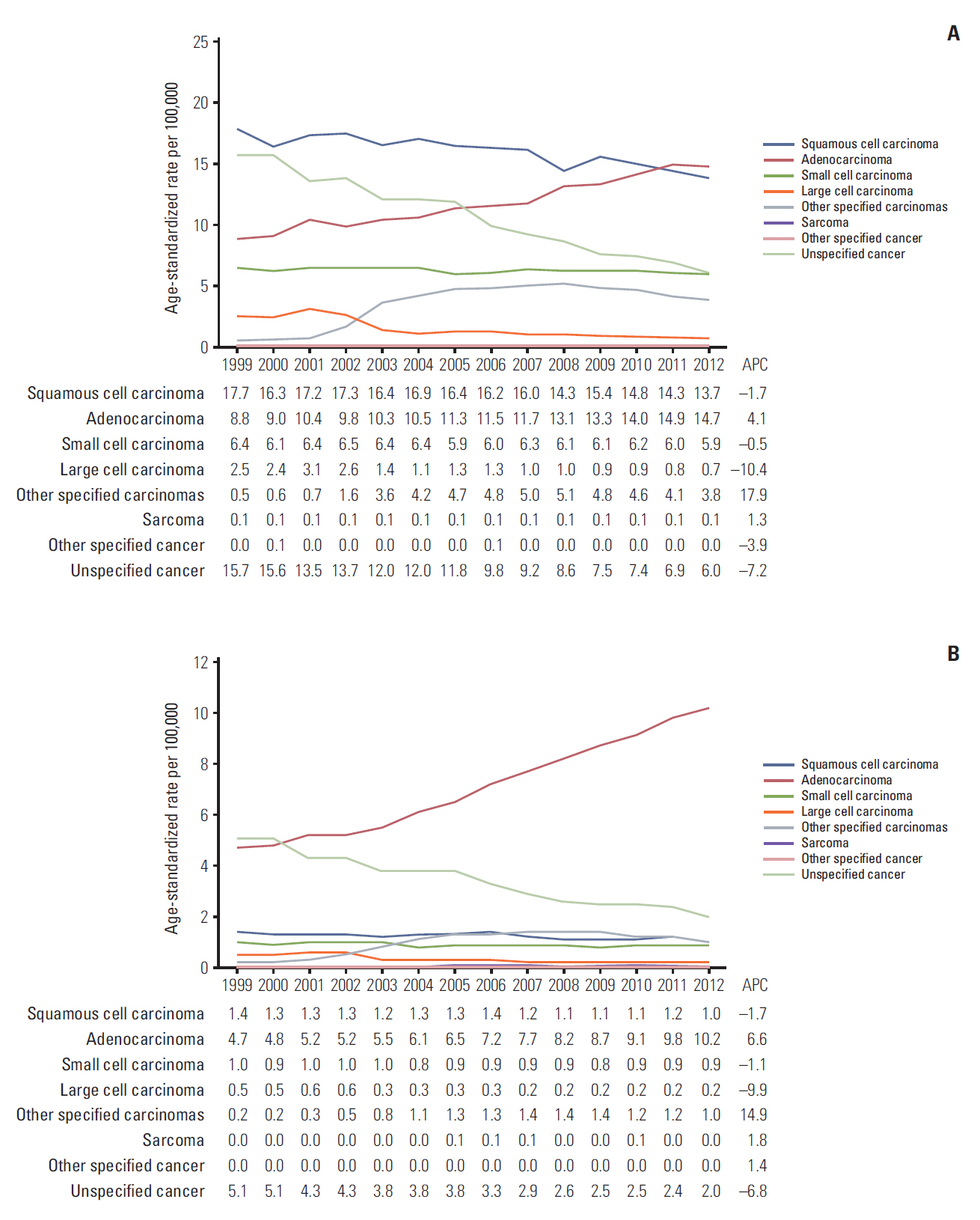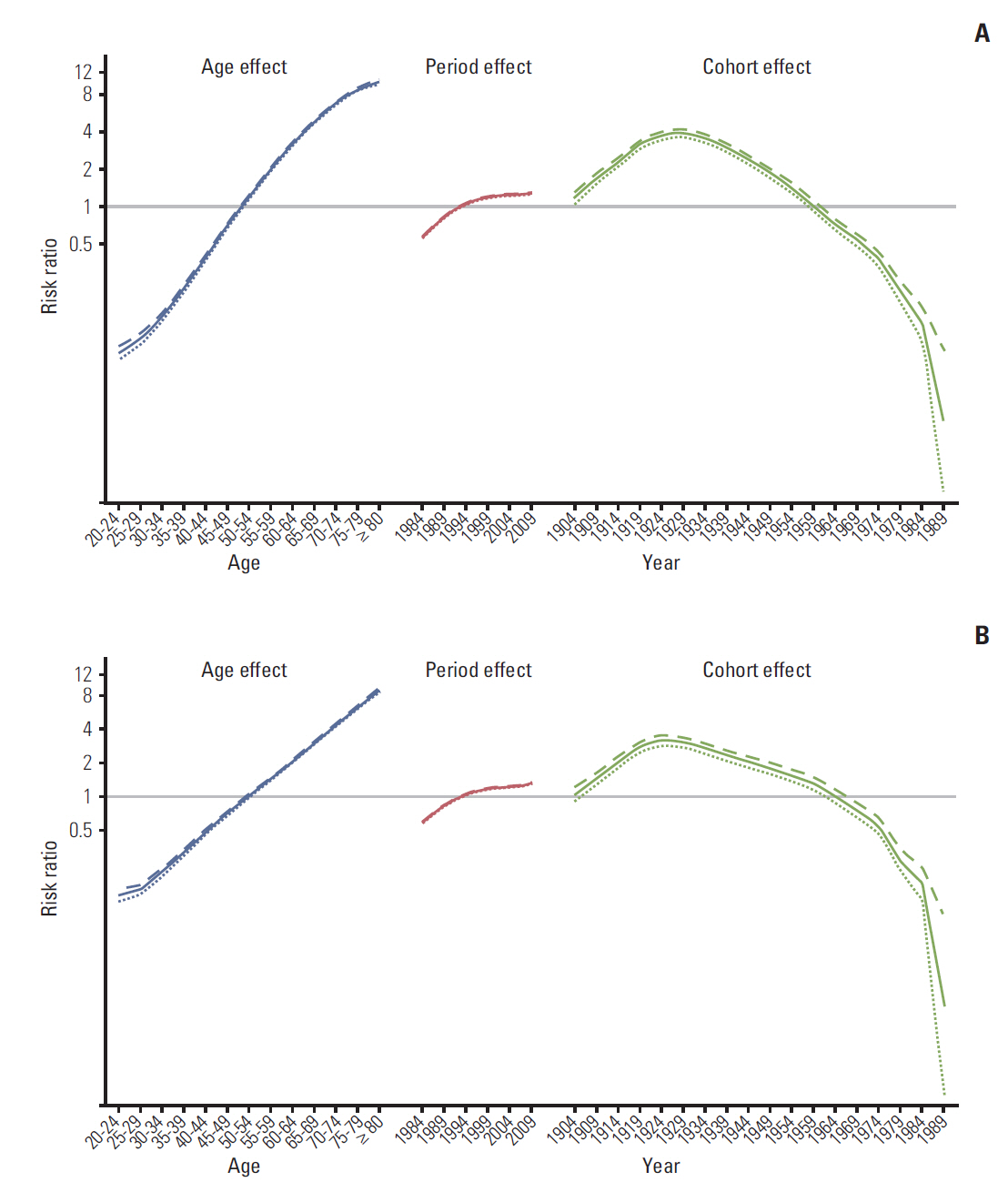Lung Cancer Epidemiology in Korea
- Affiliations
-
- 1Cancer Registration and Statistics Branch, National Cancer Center, Goyang, Korea. astra67@ncc.re.kr
- 2Department of Preventive Medicine, Seoul National University College of Medicine, Seoul, Korea.
- 3Cancer Research Institute, Seoul National University College of Medicine, Seoul, Korea.
- 4National Cancer Center Research Institute and Hospital, National Cancer Center, Goyang, Korea.
- KMID: 2388307
- DOI: http://doi.org/10.4143/crt.2016.178
Abstract
- PURPOSE
The current study was undertaken to examine the trends in the lung cancer incidence, mortality, and survival after a diagnosis in Korea.
MATERIALS AND METHODS
Lung cancer incidence data according to the histologic type and mortality data were obtained from the Korea Central Cancer Registry and the Statistics Korea, respectively. The age-standardized incidence and mortality rates were calculated, and the Joinpoint model and age-period-cohort analyses were used to describe the trends in the rates. The 5-year relative survival rates of lung cancer were also calculated.
RESULTS
Although the number of new lung cancer cases increased between 1999 and 2012, the age-standardized incidence rate decreased by 0.9% per year in men, whereas the incidence in women increased by 1.7% per year over the same time. Until 2010, the most common histologic type in men was squamous cell carcinoma, then adenocarcinoma prevailed thereafter. Since 1999, the most frequent histological type in women was adenocarcinoma. The lung cancer mortality started to decrease in 2002, with a more apparent decline for the younger age groups in both men and women. Overall, the 5-year relative survival rates have improved significantly from 11.2% for men and 14.7% for women among patients diagnosed between 1993 and 1997 to 19.3% for men and 28.2% for women among patients diagnosed between 2008 and 2012, respectively. An improvement in survival rate was observed for all major histology groups.
CONCLUSION
The epidemiology of lung cancer in Korea has changed over a short time span, with decreasing mortality and improving survival rates. Further study is warranted to determine the cause of these changes.
Keyword
MeSH Terms
Figure
Cited by 7 articles
-
The Disease Burden of Lung Cancer Attributable to Residential Radon Exposure in Korean Homes
Jong-Hun Kim, Mina Ha
J Korean Med Sci. 2018;33(29):. doi: 10.3346/jkms.2018.33.e223.Trends and Updated Statistics of Lung Cancer in Korea
Chan Kwon Park, Seung Joon Kim
Tuberc Respir Dis. 2019;82(2):175-177. doi: 10.4046/trd.2019.0015.Updates on Cancer Epidemiology in Korea, 2018
Sun-Seog Kweon
Chonnam Med J. 2018;54(2):90-100. doi: 10.4068/cmj.2018.54.2.90.Identification of Serial DNA Methylation Changes in the Blood Samples of Patients with Lung Cancer
Da Hye Moon, Sung Ok Kwon, Woo Jin Kim, Yoonki Hong
Tuberc Respir Dis. 2019;82(2):126-132. doi: 10.4046/trd.2018.0042.Clinical Characteristics and Prognostic Factors of Lung Cancer in Korea: A Pilot Study of Data from the Korean Nationwide Lung Cancer Registry
Ho Cheol Kim, Chi Young Jung, Deog Gon Cho, Jae Hyun Jeon, Jeong Eun Lee, Jin Seok Ahn, Seung Joon Kim, Yeongdae Kim, Young-Chul Kim, Jung-Eun Kim, Boram Lee, Young-Joo Won, Chang-Min Choi
Tuberc Respir Dis. 2019;82(2):118-125. doi: 10.4046/trd.2017.0128.Prevalence of Mutations in Discoidin Domain-Containing Receptor Tyrosine Kinase 2 (DDR2) in Squamous Cell Lung Cancers in Korean Patients
Mi-Sook Lee, Eun Ah Jung, Sung Bin An, Yu Jin Kim, Doo-Yi Oh, Ji-Young Song, Sang-Won Um, Joungho Han, Yoon-La Choi
Cancer Res Treat. 2017;49(4):1065-1076. doi: 10.4143/crt.2016.347.Trend Analysis for the Choice and Cost of Lung Cancer Treatment in South Korea, 2003-2013
Dohun Kim, So Young Kim, Beomseok Suh, Jong Hyock Park
Cancer Res Treat. 2018;50(3):757-767. doi: 10.4143/crt.2017.050.
Reference
-
References
1. GLOBOCAN 2012: estimated cancer incidence, mortality and prevalence worldwide in 2012. All cancers (excluding nonmelanoma skin cancer) estimated incidence, mortaliy and prevalence worldwide in 2012 [Internet]. Geneva: World Health Organization;2015. [cited 2015 Nov 13]. Available from: http://globocan.iarc.fr/Pages/fact_sheets_cancer.aspx#.2. Devesa SS, Shaw GL, Blot WJ. Changing patterns of lung cancer incidence by histological type. Cancer Epidemiol Biomarkers Prev. 1991; 1:29–34.3. Janssen-Heijnen ML, Coebergh JW. The changing epidemiology of lung cancer in Europe. Lung Cancer. 2003; 41:245–58.
Article4. Jemal A, Chu KC, Tarone RE. Recent trends in lung cancer mortality in the United States. J Natl Cancer Inst. 2001; 93:277–83.
Article5. Toyoda Y, Nakayama T, Ioka A, Tsukuma H. Trends in lung cancer incidence by histological type in Osaka, Japan. Jpn J Clin Oncol. 2008; 38:534–9.
Article6. Park S, Jee SH, Shin HR, Park EH, Shin A, Jung KW, et al. Attributable fraction of tobacco smoking on cancer using population-based nationwide cancer incidence and mortality data in Korea. BMC Cancer. 2014; 14:406.
Article7. Parkin DM. 2. Tobacco-attributable cancer burden in the UK in 2010. Br J Cancer. 2011; 105 Suppl 2:S6–S13.
Article8. Pesch B, Kendzia B, Gustavsson P, Jockel KH, Johnen G, Pohlabeln H, et al. Cigarette smoking and lung cancer: relative risk estimates for the major histological types from a pooled analysis of case-control studies. Int J Cancer. 2012; 131:1210–9.9. Jung KW, Won YJ, Kong HJ, Oh CM, Cho H, Lee DH, et al. Cancer statistics in Korea: incidence, mortality, survival, and prevalence in 2012. Cancer Res Treat. 2015; 47:127–41.
Article10. Altekruse SF, Kosary CL, Krapcho M, Neyman N, Aminou R, Waldron W, et al. SEER cancer statistics review, 1975-2007. Bethesda, MD: National Cancer Institute;2010.11. Boyle P, Parkin DM. Statistical methods for registries. In : Jensen OM, Parkin DM, MacLennan R, Muir CS, Skeet RG, editors. Cancer registration: principles and methods. Lyon: International Agency for Research on Cancer;1991.12. Kim HJ, Fay MP, Feuer EJ, Midthune DN. Permutation tests for joinpoint regression with applications to cancer rates. Stat Med. 2000; 19:335–51.
Article13. Yang Y, Fu WJ, Land KC. A methodological comparison of age‐period‐cohort models: the intrinsic estimator and conventional generalized linear models. Sociol Methodol. 2004; 34:75–110.14. Ederer F, Heise H. Instructions to IBM 650 programmers in processing survival computations. Methodological note. No. 10. End results evaluation section. Bethesda, MD: National Cancer Institute;1959.15. PaulDickman.com [Internet]. Stockholm: Paul Dickman;2015. [cited 2015 Nov 13]. Available from: http://www.pauldickman.com.16. Dickman PW, Sloggett A, Hills M, Hakulinen T. Regression models for relative survival. Stat Med. 2004; 23:51–64.
Article17. Choi S, Kim Y, Park S, Lee J, Oh K. Trends in cigarette smoking among adolescents and adults in South Korea. Epidemiol Health. 2014; 36:e2014023.18. Park EJ, Koh HK, Kwon JW, Suh MK, Kim H, Cho SI. Secular trends in adult male smoking from 1992 to 2006 in South Korea: age-specific changes with evolving tobacco-control policies. Public Health. 2009; 123:657–64.
Article19. Charloux A, Quoix E, Wolkove N, Small D, Pauli G, Kreisman H. The increasing incidence of lung adenocarcinoma: reality or artefact? A review of the epidemiology of lung adenocarcinoma. Int J Epidemiol. 1997; 26:14–23.
Article20. Lortet-Tieulent J, Soerjomataram I, Ferlay J, Rutherford M, Weiderpass E, Bray F. International trends in lung cancer incidence by histological subtype: adenocarcinoma stabilizing in men but still increasing in women. Lung Cancer. 2014; 84:13–22.
Article21. Dela Cruz CS, Tanoue LT, Matthay RA. Lung cancer: epidemiology, etiology, and prevention. Clin Chest Med. 2011; 32:605–44.
Article22. Bray FI, Weiderpass E. Lung cancer mortality trends in 36 European countries: secular trends and birth cohort patterns by sex and region 1970-2007. Int J Cancer. 2010; 126:1454–66.
Article23. Adair T, Hoy D, Dettrick Z, Lopez AD. Reconstruction of long-term tobacco consumption trends in Australia and their relationship to lung cancer mortality. Cancer Causes Control. 2011; 22:1047–53.
Article24. Thun M, Peto R, Boreham J, Lopez AD. Stages of the cigarette epidemic on entering its second century. Tob Control. 2012; 21:96–101.
Article25. Choi Y, Kim Y, Hong YC, Park SK, Yoo KY. Temporal changes of lung cancer mortality in Korea. J Korean Med Sci. 2007; 22:524–8.
Article26. Lynch TJ, Bell DW, Sordella R, Gurubhagavatula S, Okimoto RA, Brannigan BW, et al. Activating mutations in the epidermal growth factor receptor underlying responsiveness of nonsmall-cell lung cancer to gefitinib. N Engl J Med. 2004; 350:2129–39.
Article27. Dillman RO, McClure SE. Steadily improving survival in lung cancer. Clin Lung Cancer. 2014; 15:331–7.
Article28. Berghmans T, Paesmans M, Meert AP, Mascaux C, Lothaire P, Lafitte JJ, et al. Survival improvement in resectable non-small cell lung cancer with (neo)adjuvant chemotherapy: results of a meta-analysis of the literature. Lung Cancer. 2005; 49:13–23.
Article29. Horn L, Lovly CM, Johnson DH. Neoplasms of the lung. In : Kasper D, Fauci A, Hauser S, Longo D, Jameson JL, Loscalzo J, editors. Harrison's principles of internal medicine. 19th ed. New York: McGraw-Hill;2015.30. Korea Central Cancer Registry; National Cancer Center. Annual report of cancer statistics in Korea in 2012. Goyang: Korea Central Cancer Registry, National Cancer Center;2014.
- Full Text Links
- Actions
-
Cited
- CITED
-
- Close
- Share
- Similar articles
-
- Epidemiology of Lung Cancer in Korea
- Joint Statement of the Ad-hoc Committee of the Korean Society for Preventive Medicine and the Korean Society of Epidemiology on Tobacco Lawsuits on the causal link between tobacco smoking and lung cancer
- Epidemiology of Lung Cancer in Korea: Recent Trends
- Joint Statement of the Ad-hoc Committee of the Korean Society for Preventive Medicine and the Korean Society of Epidemiology on Tobacco Lawsuits on the Causal Link Between Tobacco Smoking and Lung Cancer
- Screening for Lung Cancer




